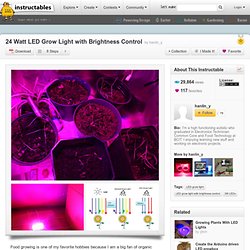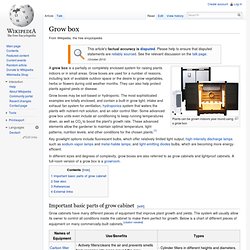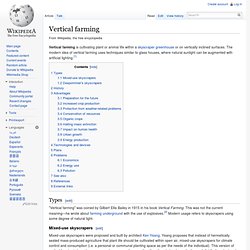

The Fuse Factory Electronic and Digital Arts Lab. 24 Watt LED Grow Light with Brightness Control. Greenhouse Aluminum foil Large box Plastic board Grow lamp 2 x 3W royal blue LED (445nm) 6 x 3W deep red LED (660 nm) Heatsink with fan Thermal paste Epoxy Solder (lead free when growing edibles) Note: You can get LEDs at e-Bay for as little as $2 each when you purchase them whole sale.

LED Driver 1A fuse with clips Resistors (0.33, 0.56, 1, and 100k ohm) N-channel MOSFET (eg. IRF540N) with heatsink General purpose NPN transistor (eg. 2N3904) Enclosure Switches 1A adapters (see below) DC adapter socket 26 gauge wires (Correct sizing for current ratings can be found here) Finding the right voltage adapter You can find adapters at a low price at used computer stores, second hand stores, electronic stores, and ebay.
Note: Fuses and wires may cause a small drop of voltage so you may want an overhead voltage of at least 1V. Tools: Multimeter capable of measuring several amps Light meter (optional) Electric timer (optional) Grow box. Plants can be grown indoors year round using a grow box A grow box is a partially or completely enclosed system for raising plants indoors or in small areas.

Grow boxes are used for a number of reasons, including lack of available outdoor space or the desire to grow vegetables, herbs or flowers during cold weather months. They can also help protect plants against pests or disease. Grow boxes may be soil-based or hydroponic. The most sophisticated examples are totally enclosed, and contain a built-in grow light, intake and exhaust fan system for ventilation, hydroponics system that waters the plants with nutrient-rich solution, and an odor control filter. Vertical farming. Vertical farming is cultivating plant or animal life within a skyscraper greenhouse or on vertically inclined surfaces.

The modern idea of vertical farming uses techniques similar to glass houses, where natural sunlight can be augmented with artificial lighting.[1] Types[edit] "Vertical farming" was coined by Gilbert Ellis Bailey in 1915 in his book Vertical Farming. This was not the current meaning—he wrote about farming underground with the use of explosives.[2] Modern usage refers to skyscrapers using some degree of natural light. Mixed-use skyscrapers[edit] Mixed-use skyscrapers were proposed and built by architect Ken Yeang. Despommier's skyscrapers[edit] Ecologist Dickson Despommier argues that vertical farming is legitimate for environmental reasons. Vertical farming according to Despommier thus discounts the value of natural landscape in exchange for the idea of "skyscraper as spaceship". Despommier's concept of "The Vertical Farm" emerged in 1999 at Columbia University. Microbial Fuel Cells: Generating Power from Waste. Microbial Fuel Cells (MFCs) use bacteria to convert organic waste material into electrical energy.

This environmentally-friendly process produces electricity without the combustion of fossil fuels. MFCs have various practical applications such as in breweries, domestic wastewater treatment, desalination plants, hydrogen production, remote sensing, and pollution remediation, and they can be used as a remote power source. Widespread use of MFCs in these areas can take our waste products and transform them into energy.
Introduction Washing one’s hands with soap is usually accompanied with the satisfaction of killing harmful germs. MFCs are especially valuable in that there are many applications of their use help to reduce pollution and cut water treatment costs in a sustainable and environmentally-friendly way. What is a microbial fuel cell? The Internet Of Things Is People, Innovating. For an object that has come to symbolize great ideas, there sure hasn't been that much innovation surrounding lightbulbs.

But that's going to change very soon. And not in the relatively humdrum manner of eco-friendly fluorescent units. We mean radically, in a as-smart-as-science-fiction kind of way. And there is much more domestic alchemy where that comes from. Tomorrow In Lights Picture a lightbulb. Now picture a totally different kind of bulb. It's smart enough that if you put it in a bedside lamp it could detect that you've woken and are heading for that midnight leak--and it knows the time, so it automatically turns on dimly to not hurt your eyes. A group of smart lamps could be intelligent enough to chatter to one another over Wi-Fi, allowing you to create amazing lighting "scenes" for your home, just like a lighting engineer in a theater. By being made smart, the simple lightbulb is transformed. What will happen to home decor? Smart Chips With An Internet Sauce.